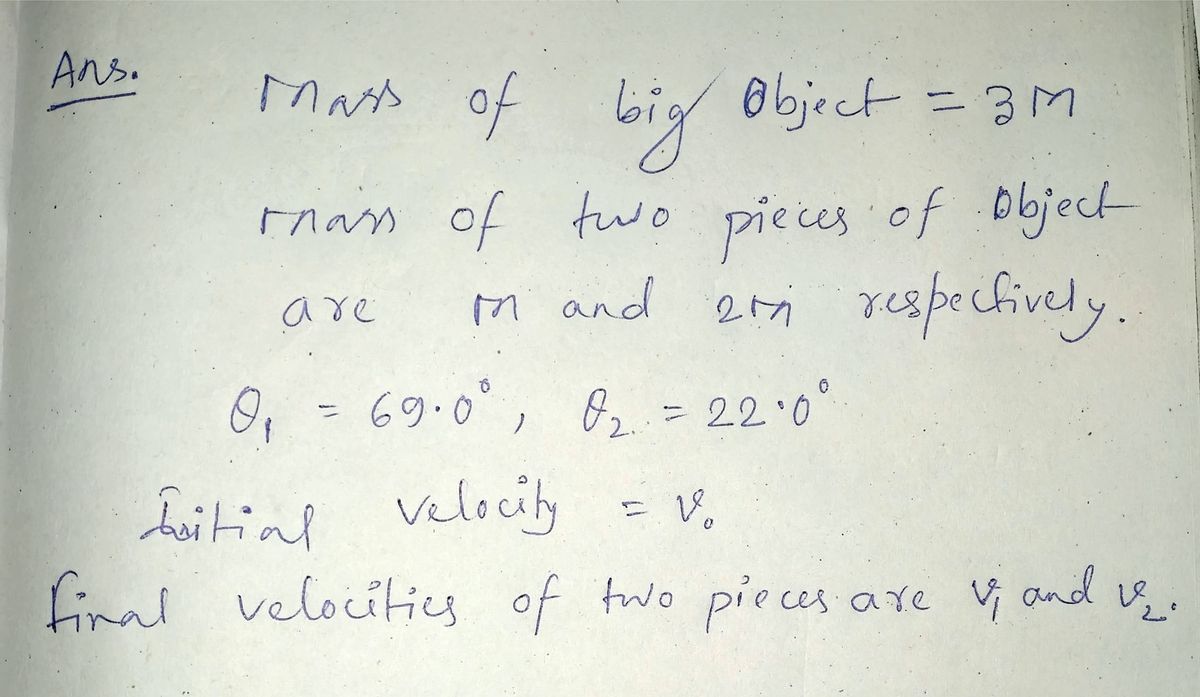O Macmillan Learning An object of mass 3 M, moving in the +x direction at speed vo, breaks into two pieces of mass M and 2M as shown in the figure. If 0₁ = 69.0° and 02 = 22.0°, determine the final velocities U₁ and 2 of the resulting pieces in terms of vo. VI U2 = 1.155 Incorrect 1.4 VO VO 3M Vo 2M M 1/2₂2 = ? 0. V₁ = ?
O Macmillan Learning An object of mass 3 M, moving in the +x direction at speed vo, breaks into two pieces of mass M and 2M as shown in the figure. If 0₁ = 69.0° and 02 = 22.0°, determine the final velocities U₁ and 2 of the resulting pieces in terms of vo. VI U2 = 1.155 Incorrect 1.4 VO VO 3M Vo 2M M 1/2₂2 = ? 0. V₁ = ?
Related questions
Question
![**Physics Problem: Momentum and Vector Analysis**
An object of mass \(3M\), moving in the \(+x\) direction at speed \(v_0\), breaks into two pieces of mass \(M\) and \(2M\) as shown in the figure.
If \(\theta_1 = 69.0^\circ\) and \(\theta_2 = 22.0^\circ\), determine the final velocities \(v_1\) and \(v_2\) of the resulting pieces in terms of \(v_0\).
- **Diagram Explanation:**
- The initial object with mass \(3M\) is depicted as a large blue sphere moving rightward with velocity \(v_0\).
- After breaking, it splits into two smaller spheres:
- A green sphere with mass \(2M\).
- An orange sphere with mass \(M\).
- The angle \(\theta_1\) is shown as the angle made by the \(M\) piece with the x-axis and is \(69.0^\circ\).
- The angle \(\theta_2\) is shown as the angle made by the \(2M\) piece with the x-axis and is \(22.0^\circ\).
- **Equations for Final Velocities:**
- Velocity \(v_1\) for mass \(M\) is given as:
\[
v_1 = \text{Incorrect value shown as } 1.155 \, v_0
\]
- Velocity \(v_2\) for mass \(2M\) is calculated as:
\[
v_2 = 1.4 \, v_0
\]
**Note to Students:**
- Ensure to use momentum conservation and vector component analysis to correctly derive \(v_1\) and \(v_2\).
- Re-calculate if required, keeping in mind the system's momentum before and after the explosion must be equal, decomposing the problem into x and y components.](/v2/_next/image?url=https%3A%2F%2Fcontent.bartleby.com%2Fqna-images%2Fquestion%2F0b319816-3828-4c3a-a4b8-8b6da6d278f2%2Fc1be3b64-dcd7-475a-82f8-79b7eb6961a5%2Flzogls8_processed.jpeg&w=3840&q=75)
Transcribed Image Text:**Physics Problem: Momentum and Vector Analysis**
An object of mass \(3M\), moving in the \(+x\) direction at speed \(v_0\), breaks into two pieces of mass \(M\) and \(2M\) as shown in the figure.
If \(\theta_1 = 69.0^\circ\) and \(\theta_2 = 22.0^\circ\), determine the final velocities \(v_1\) and \(v_2\) of the resulting pieces in terms of \(v_0\).
- **Diagram Explanation:**
- The initial object with mass \(3M\) is depicted as a large blue sphere moving rightward with velocity \(v_0\).
- After breaking, it splits into two smaller spheres:
- A green sphere with mass \(2M\).
- An orange sphere with mass \(M\).
- The angle \(\theta_1\) is shown as the angle made by the \(M\) piece with the x-axis and is \(69.0^\circ\).
- The angle \(\theta_2\) is shown as the angle made by the \(2M\) piece with the x-axis and is \(22.0^\circ\).
- **Equations for Final Velocities:**
- Velocity \(v_1\) for mass \(M\) is given as:
\[
v_1 = \text{Incorrect value shown as } 1.155 \, v_0
\]
- Velocity \(v_2\) for mass \(2M\) is calculated as:
\[
v_2 = 1.4 \, v_0
\]
**Note to Students:**
- Ensure to use momentum conservation and vector component analysis to correctly derive \(v_1\) and \(v_2\).
- Re-calculate if required, keeping in mind the system's momentum before and after the explosion must be equal, decomposing the problem into x and y components.
Expert Solution
Step 1

Step by step
Solved in 3 steps with 3 images
